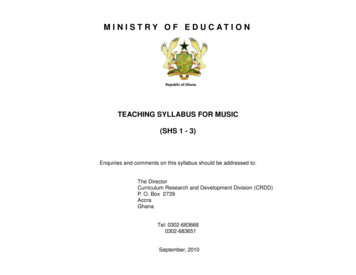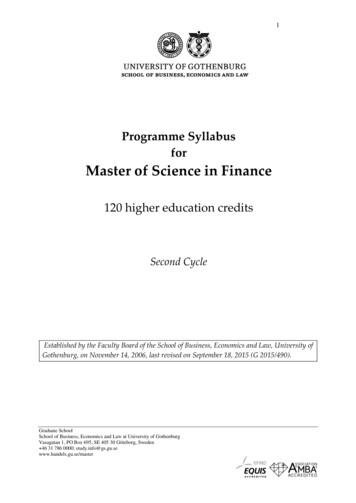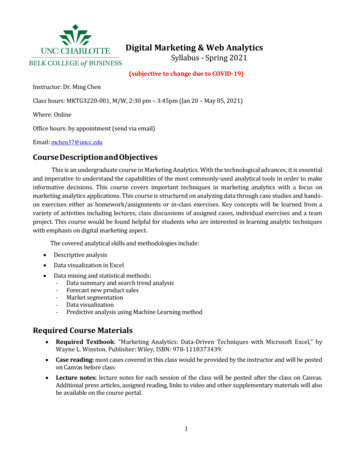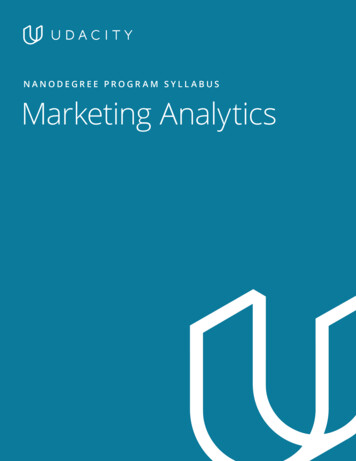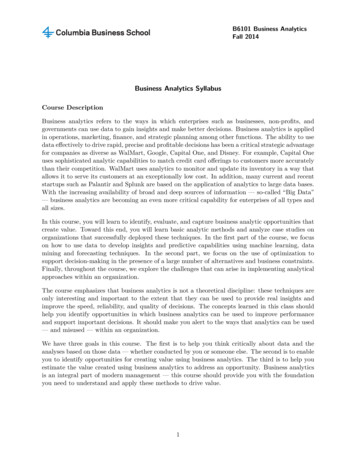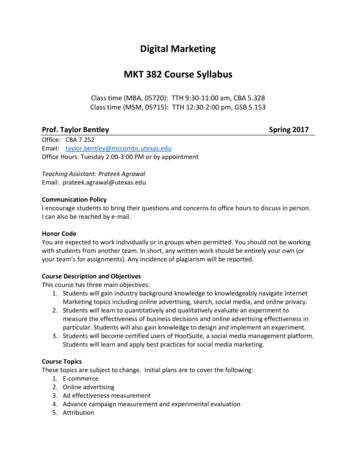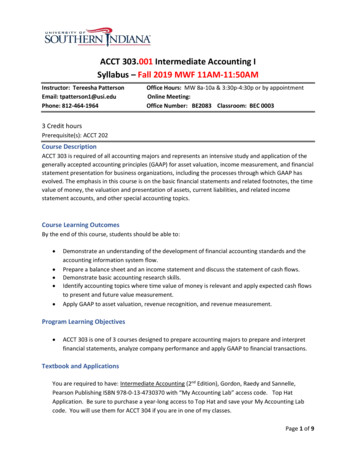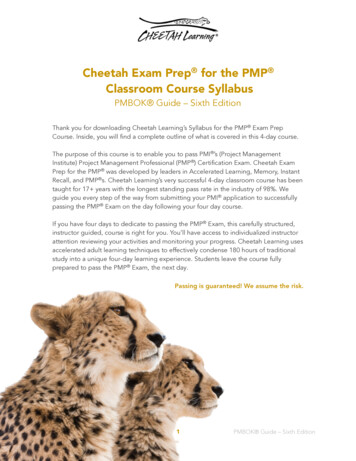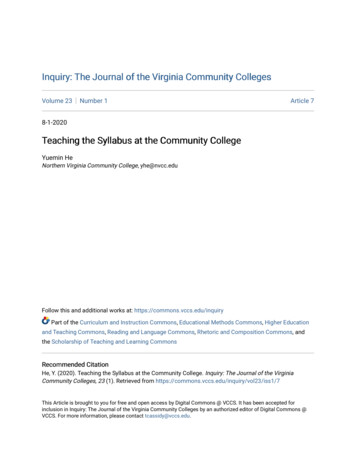
Transcription
Inquiry: The Journal of the Virginia Community CollegesVolume 23Number 1Article 78-1-2020Teaching the Syllabus at the Community CollegeYuemin HeNorthern Virginia Community College, yhe@nvcc.eduFollow this and additional works at: https://commons.vccs.edu/inquiryPart of the Curriculum and Instruction Commons, Educational Methods Commons, Higher Educationand Teaching Commons, Reading and Language Commons, Rhetoric and Composition Commons, andthe Scholarship of Teaching and Learning CommonsRecommended CitationHe, Y. (2020). Teaching the Syllabus at the Community College. Inquiry: The Journal of the VirginiaCommunity Colleges, 23 (1). Retrieved from https://commons.vccs.edu/inquiry/vol23/iss1/7This Article is brought to you for free and open access by Digital Commons @ VCCS. It has been accepted forinclusion in Inquiry: The Journal of the Virginia Community Colleges by an authorized editor of Digital Commons @VCCS. For more information, please contact tcassidy@vccs.edu.
Teaching the Syllabus at the Community CollegeCover Page FootnoteI would like to thank Dean Jen Daniels for her superb guidance, support, and feedback throughout theproject. I also thank my colleagues Susanna Ferrara for allowing me to use her “Three Appeals”assignment and Nicole Tong and Ray Orkwis for sharing their syllabi; Randa Gray, Ray Orkwis, SarahJacobson, Cathy Gaiser, Steven Lessener, Bryan L. Peters, Amy Flessert, Jane F. Friedmann, and Sophia A.Sexton for helping conduct the questionnaire; Hector Revollo for technical support; and our emeritusprofessors Reva A. Savkar and Robert C. Loser and the college Loser-Savkar Fellowship SelectionCommittee for research time support. Last but most importantly, I am grateful to our students for theirvaluable responses. This work is for them.This article is available in Inquiry: The Journal of the Virginia Community Colleges: https://commons.vccs.edu/inquiry/vol23/iss1/7
He: Teaching the SyllabusTEACHING THE SYLLABUS AT THE COMMUNITY COLLEGEYUEMIN HE, PH.D.ABSTRACTReacting directly to the fact that even the best syllabus is worthless to the student whodoes not read it, this essay draws inspiration from research of the past decade, especially fromthe learning-focused syllabus concept that was introduced by three researchers at the Universityof Virginia, and uses a questionnaire to gauge our community college students’ needs. It suggestsspecific methods to build the bridge between course content instruction and syllabus teaching.Ultimately, it contributes to the discussion of several important syllabus-related questions: Howcan instructors use the syllabus as a pedagogical tool to build a strong student rapport? How caninstructors balance the syllabus to build a positive academic atmosphere and fulfill courserequirements? What are the ways to make the syllabus exemplary for student learning? Whatstandard practices can be established in college syllabus education? The essay aims to increasestudent autonomy and community and student success, which is the goal of community collegeeducation.INTRODUCTIONAs community college instructors, we have some routine practices regarding the syllabus:Before a semester unfolds, we spend days crafting the assignments, updating the schedules, andtweaking our policies. We post the document in our Learning Management Systems and distributehard copies on the first day of class. Some call the first day of class the syllabus day because ofPublished by Digital Commons @ VCCS, 20201
Inquiry: The Journal of the Virginia Community Colleges, Vol. 23, No. 1 [2020], Art. 7the time and effort dedicated to getting students to read and absorb the vital information included.We use quizzes, games, group discussions, etc., to ensure that the document is read andremembered all semester long, and yet, how many times do we repeat what is in the syllabus?Students ask where to find us outside of class, when our office hours are, when assignments aredue, and sometimes in the division offices, we have even overheard them asking what our namesare. Despite the great importance we put on the syllabus, and our efforts to make it accessible andmemorable, it is often neglected or undervalued.It is no wonder scholars have conducted vigorous studies, striving to make the syllabus andits use more efficacious. In their article “Syllabus Detail and Students' Perceptions of TeacherEffectiveness,” Bryan K. Saville and his co-authors (2010) asserted that a very detailed syllabusmay generate more positive responses from the students (p. 188). When writing about studentplagiarism, Sara Staats and Julie M. Hupp (2012) reported in “An Examination of AcademicMisconduct Intentions and the Ineffectiveness of Syllabus Statements” that the syllabus as astatement itself, even if cognitively processed, is not a deterrent to student malpractice. They calledfor more innovative approaches to enhance the effectiveness of the statement in curtailingdishonesty (p. 244). While emphasizing close attention to details in syllabus construction, Jade S.Jenkins and her co-authors (2014) suggested in “More Content or More Policy? A Closer Look atSyllabus Detail, Instructor Gender, and Perceptions of Instructor Effectiveness” that genderdifferences of the instructors do not affect the effectiveness of restrictive boundary details (i.e.,restrictive policies and expectations) in the syllabus; instead, it is the way the information ispresented rather than the information itself that is relevant to students’ perceived instructor supportand effectiveness (p. 133). Later Claudia Stanny (2015), the director of the Center for UniversityTeaching, Learning, and Assessment of the University of West Florida, published “Assessing thehttps://commons.vccs.edu/inquiry/vol23/iss1/72
He: Teaching the SyllabusCulture of Teaching and Learning through a Syllabus Review” to advocate aligning the syllabusconstruction and teaching with the 21st century skills of both the instructors and students (i.e.,aligning institutional syllabus review measures with activities and assignments designed tocultivate student skills in information literacy and digital communication). When it comes to thesyllabus, “a few compulsive sorts may pore over every letter. Others may refer to it only whenthere is a problem. Many may never look at it at all” (p. 37). Therefore, Mark Canada (2013)prompted his fellow instructors in his essay, “The Syllabus: A Place to Engage Students' Egos,”to put themselves in their students’ shoes, and ask the question that their students would ask aboutthe syllabus: “what’s in it for me?” (p. 42).These studies provide instructors with valuable tools to employ and paradigms to rethinkour practices in teaching and using the syllabus. In 2016, University of Virginia (hereafter UVA)researchers--Michael S. Palmer, Lindsay B. Wheeler, and Itiya Aneece--transformed that questioninto a more provocative one: Does the syllabus matter? In their article, “Does the Document Matter:The Evolving Role of Syllabi in Higher Education,” they answered that question with a qualified“yes” and promoted what they call the learning-focused syllabus. They pointed out that thetraditional content-based syllabus has become increasingly authoritative and rule-infested; it stiflesstudent motivation and hinders student learning. In contrast, the learning-focused syllabus ischaracterized by “question-driven course descriptions,” “long-ranging, multi-faceted learninggoals,” clear and measurable learning objectives, detailed course schedules, and an approachableand inviting tone (p. 36). In other words, the learning-focused syllabus is student-centered anddesigned to engage students actively with the document and the course.After surveying 100 students on their perceptions of a traditional syllabus and a learningfocused syllabus for the same course, the three researchers concluded that both types of syllabiPublished by Digital Commons @ VCCS, 20203
Inquiry: The Journal of the Virginia Community Colleges, Vol. 23, No. 1 [2020], Art. 7were useful to students but the learning-focused syllabus created more positive perceptions of thesyllabus itself, the course and the instructor. They reported that the UVA students in the study“viewed the learning-focused syllabus as a useful, organizing document, the course as aninteresting, relevant, and rigorous learning experience, and the instructor as a caring and supportiveindividual integral to the learning process” (p. 46). Since student engagement impacts retentionand student success, I wanted to figure out if the learning-focused syllabus had the same positiveimpacts on the very diverse, frequently multi-lingual learners in my community college classrooms.Our students come from over 180 different countries; 60 percent of this student body isethnic or racial minorities. Many come from countries where syllabi are literally non-existent. Itaught more than a decade in a college in China without seeing a Western syllabus; some sort ofteaching plan was routinely used by the instructors, but it was never given to the students, nor wasthe plan a full-fledged and systematically developed syllabus. Just last year, I met two Chinesegraduate students at an international conference in Indonesia. When speaking of syllabus, thestudents reported that their professor, who had returned from Ph.D. study in the United States, wasjust in the process of distributing to the class a document that bore resemblance to the Americansyllabus.To do this, I collaborated with Dean Jen Daniels and developed a questionnaire that askedquestions in the spirit of the above research. Ultimately, we wanted to increase student engagementand find specific ways to educate our students about the usefulness of the syllabus and theconnection between syllabus teaching and our daily course content instruction.USING A QUESTIONNAIRE TO IDENTIFY COMMUNITY COLLEGE STUDENTS’ 4
He: Teaching the SyllabusTitled “Syllabus for You,” the questionnaire (see Appendix D) includes nine multipleanswer questions: The first five questions gather information on student use of the syllabus andtheir knowledge of common syllabus conventions. The final four questions ask students to reviewsample policies following traditional syllabus conventions (third-person, boilerplate policies)versus the learning-focused ones. In other words, the questionnaire examines how muchrespondents know about the syllabus, where their challenges lie in understanding the syllabus,what common practices they adopt in terms of syllabus use, etc. It leads to answers that can helpgauge receptiveness to the characteristics of a learning-focused syllabus as well.We conducted two rounds of the questionnaire within the English Department at NorthernVirginia Community College (hereafter NOVA), Annandale Campus: first with 180 students fromENF 3-ENG 111 (Preparing for College English III & College Composition I) and ENG 111(College Composition I) classes in fall 2018, and then with 241 students from ENF 3-ENG 111and ENG 111 classes in spring 2019. A total of 421 students participated in the survey, and bothrounds ended up with more than a 50 percent student response rate. Both ENF 3 and ENG 111were selected because they are gateway courses in which most students enroll; their success incollege is often predicated on performance in gateway courses like ENF 3 and ENG 111. Belowis a brief analysis of the student responses.Question 1: For the question “When did you first understand what a syllabus was,” at least twicethe number of students in ENF 3-ENG 111 than in ENG 111 answered “After I came to NOVA(or another college).” ENF 3-ENG 111 students were more likely to have been introduced to theconcept of the syllabus in college rather than in high school or earlier. The survey result thus pointsto the need for instructors to adopt different strategies in using the aforementioned Syllabus Day:In teaching students in the first-semester, gateway courses in all disciplines, we need to be morePublished by Digital Commons @ VCCS, 20205
Inquiry: The Journal of the Virginia Community Colleges, Vol. 23, No. 1 [2020], Art. 7explicit about the use and importance of the syllabus. For that purpose, systematic syllabus trainingactivities, such as the one introduced later in this essay, may be adopted. Whereas, we can refreshand reinforce the knowledge that our more prepared students have about the syllabus by “flippingthe classroom,” such as arranging diagnostic assessment activities creatively. Appendix B is anexample of such activities, and I will discuss the example in detail.Question 2: More than 20 percent of students from each group believed “the syllabus is importantONLY at the beginning of the class because I need it to figure out what the semester will be likeat the start.” Nearly 80 percent of students from each group responded that “the syllabus isimportant every day because it contains information about due dates, attendance policies, officehours, and I can find information I need without having to ask the instructor.” This is good newsfor those of us who sometimes despair that no one reads the syllabus. The question becomes howto reach the 20% who do not understand the holistic functions of the syllabus. One solution Isuggest is to teach the syllabus itself as a work model, which will make it necessary for our studentsto pore over the whole document early in the semester, assess its long-term functions, and integratethe document into their daily learning habits. In the last part of this essay I will offer one concreteexample while discussing this model approach.Question 3: More than 10 percent of the students from both groups could not read the office hoursprovided. The results from the two rounds of research echoed each other. Slightly more (some 3percent) ENF 3-ENG 111 students than ENG 111 students could not read the office hours byappointment correctly. The results from the two rounds of survey concurred as well. Our takeawayis that what instructors consider to be clear as day may not be that clear to the students at all.Community college faculty play an important role in helping first-generation and other new-tocollege students decode the academic jargon and abbreviations in which we are immersed. Thehttps://commons.vccs.edu/inquiry/vol23/iss1/76
He: Teaching the Syllabusstudents who often solicit confirmation from us may just need some education about what thedifferent types of office hours are, what they entail, and what the commonly used abbreviations inthe syllabus are (ex. R Thursday).Question 4: To the question, “How do you feel if your class syllabus states ‘Office Hours: Beforeand After Class’,” slightly more than 10 percent of the students from each group considered “theoffice hours not written in a student-friendly manner” while at least a quarter of the students fromboth groups felt “the professor is quite flexible with the office hours.” It seems that more studentstrusted that the professor was well-intentioned than believed that the professor failed to write thesyllabus in a student-friendly manner. The statement sounds friendly; however, the underlyingambiguity in the statement can lead to confusion (ex. How early before class? How long after?).Question 5: While more than 70 percent of the students knew the importance of reading both theCourse Description and Course Objectives in a syllabus, neither group of the students seemed toperceive the connections between the two sections, let alone see much value in thinking muchabout either section. Apparently instructors need to illuminate the students about the necessity for,and purposes of, these two sections, individually and in conjunction with each other. The students’lack of understanding of the interconnection between differnt sections of the syllabus alsobehooves us instructors to be creative in writing course syllabus. For example, the UVAresearchers advocated the “question-driven course descriptions,” which Ben Kain (2004), authorof What the Best College Teachers Do, dubbed as “beautiful questions.” This type of descriptionsemphasizes framing the course content as questions to be explored and answered by students (p.37). They are inviting, treating the students as fellow scholars or engaged competent learners. Forexample, in my ENG 125 (Introduction to Literature) syllabus, instead of a traditional coursePublished by Digital Commons @ VCCS, 20207
Inquiry: The Journal of the Virginia Community Colleges, Vol. 23, No. 1 [2020], Art. 7description, I borrowed some ideas from The Hatred of Literaure, a book by William Marx(20015/2018), and wrote:Book writer William Marx says that literature does not start with Homer or Gilgamesh, butwith Plato driving the poets out of the city, like God casting Adam and Eve out of Paradise.That is literature’s genesis (p. 24). Literature survived and has been thriving. Why literaturehas the power to defy all the anti-literary discourses? Why without literature human lifesaps? What is literature anyways? This course introduces a range of literary genres to helpcontemplate these questions as it continues to develop our college writing ability.Question 6: To the question “Which statement or statements on attendance do you prefer,” thequestionnaire lists four choices, two of which area) If you are ill or can’t make it, let me know, ahead of time if possible, or by email, so that I canmark you as excused. But bear in mind that an excused absence still counts as an absence. Eventhough I post your assignments on Blackboard, there is no way to learn what you would havegotten in class by merely asking me, “What did I miss?” The truth is that you missed 75 minutesof learning.b) Send me an email at XXXX@nvcc.edu to notify me that you will not be there. I do not needthe reason, only the statement that you will be absent.Check Blackboard, but do not expect that everything we did in class will beavailable there.Contact another student prior to the next class to find out what you missed.Ask me for clarification, not for what you missed.More students in ENG 111 than in ENF3-ENG 111 chose the student-friendly statement a), ratherthan the traditional statement b) that uses bolding, underlining, and an imperative tone. Thedifference in student responses confirms the UVA researchers’ discovery that the syllabus 78
He: Teaching the Syllabusnot be authoritarian, cold, and alienating. It demonstrates that the learning-focused syllabus is moresupportive and warmer, and students are more likely to perceive the syllabus positively.Question 7: As one of the choices for question 7, the more traditional statement “Students wishingto speak with a professor should.” was selected by only 10 percent of the students from bothgroups. Narrating in the third person and using “students” as the subject does not inviteengagement: It demands that the students take the initiative to open a dialogue with their professor,rather than warmly welcoming the students to seek the professor’s help. The responses to thisquestion further attest to the importance of adopting a caring tone in syllabus construction.Question 8: To the question “What do you like to see in a syllabus in terms of how your professorpresents information?” The reactions from both groups were similar. They overwhelmingly chosethe presentations that used colors, tables, charts, and/or with interactive components and avoidedtheir more static-looking, text-heavy versions.Question 9: Among all the students who responded to the questionnaire, slightly more than 20percent of the ENG 111 students noted that they did not care which style the syllabus was writtenin. Only 3 percent more students in ENG 111 than in ENF 3-ENG 111 chose the learning-focusedsyllabus course over the traditional syllabus one. This result is interesting; it can either mean thedifferences in style may not be that decis
Northern Virginia Community College, yhe@nvcc.edu Follow this and additional works at: https://commons.vccs.edu/inquiry . . characterized by “question-driven course descriptions,” “long-ranging, multi-faceted learning goals,” clear and measurable learning objectives, detailed
